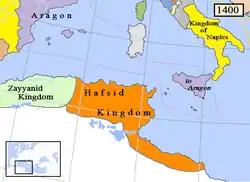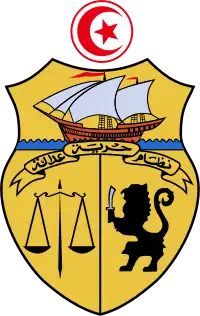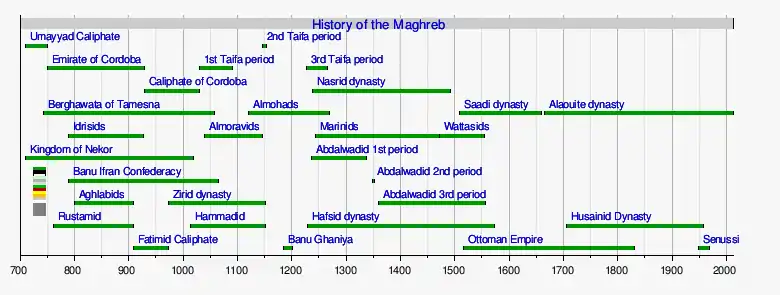Hafsid dynasty
The Hafsids (Arabic: الحفصيون al-Ḥafṣiyūn) were a Sunni Muslim dynasty of Berber descent[3] who ruled Ifriqiya (western Libya, Tunisia, and eastern Algeria) from 1229 to 1574.
Hafsid Kingdom Sultanate of Tunis | |||||||||||||||
|---|---|---|---|---|---|---|---|---|---|---|---|---|---|---|---|
| 1229–1574 | |||||||||||||||
  | |||||||||||||||
 Realm of the Hafsid dynasty in 1400 (orange) | |||||||||||||||
| Capital | Tunis | ||||||||||||||
| Common languages | Berber, Maghrebi Arabic | ||||||||||||||
| Religion | Islam (Sunni, Ibadi), Christianity (Roman Catholic), Judaism | ||||||||||||||
| Government | Monarchy | ||||||||||||||
| Sultanate | |||||||||||||||
• 1229–1249 | Abu Zakariya | ||||||||||||||
• 1574 | Muhammad VI | ||||||||||||||
| History | |||||||||||||||
• Established | 1229 | ||||||||||||||
| 1535 | |||||||||||||||
• Disestablished | 1574 | ||||||||||||||
| |||||||||||||||
| Today part of | |||||||||||||||
History
Almohad Ifriqiya
The ancestor of the dynasty was Abu Hafs Umar ibn Yahya al-Hintati, a Berber from the Hintata tribal confederation which belonged to the greater Masmuda confederation of Morocco. He was a member of the council of ten and a close companion of Ibn Tumart. His original Berber name was "Faskat u-Mzal Inti", which later was changed to "Abu Hafs Umar ibn Yahya al-Hintati" (also known as "Umar Inti") since it was a tradition of Ibn Tumart to rename his close companions once they had adhered to his religious teachings. His son Abu Muhammad Abd al-Wahid ibn Abi Hafs, was appointed by the Almohad caliph Muhammad an-Nasir as governor of Ifriqiya (present day Tunisia), where he ruled from 1207 to 1221.[4][5][6] The Hafsids as governors on behalf of the Almohads faced constant threats from Banu Ghaniya who were descendants of Almoravid princes which the Almohads had defeated and replaced as a ruling dynasty.
Hafsid Kingdom and Caliphate
The Hafsids were Ifriqiya governors of the Almohads until 1229, when they declared independence. After the split of the Hafsids from the Almohads under Abu Zakariya (1228–1249), Abu Zakariya organised the administration in Ifriqiya (the Roman province of Africa in modern Maghreb; today's Tunisia, eastern Algeria and western Libya) and built the city of Tunis up as the economic and cultural centre of the empire. At the same time, many Muslims from Al-Andalus fleeing the Spanish Reconquista of Castile and Aragon were absorbed. He also conquered the Kingdom of Tlemcen in 1242 and made the Abdalwadids his vassals. His successor Muhammad I al-Mustansir (1249–1277) took the title of Caliph.
He extended the boundaries of his State by subjugating the central Maghreb, going so far as to impose his overlordship over the Kingdom of Tlemcen, northern Morocco and the Nasrids of Granada Spain. The Hafsids become completely independent in 1264. The successor of Abû Zakariya' Yahya, Abu ' Abd Allah Muhammad al-Mustansir, proclaimed himself Caliph in 1256 and continued the policies of his father. It was during his reign that the failed Eighth Crusade took place, led by St. Louis. After landing at Carthage, the King died of dysentery in the middle of his army decimated by disease in 1270.
Hafsid decline (14th century)
In the 14th century the empire underwent a temporary decline. Although the Hafsids succeeded for a time in subjugating the empire of the Abdalwadids of Tlemcen, between 1347 and 1357 they were twice conquered by the Marinids of Morocco. The Abdalwadids however could not defeat the Bedouin; ultimately, the Hafsids were able to regain their empire. During the same period plague epidemics brought to Ifriqiya from Sicily caused a considerable fall in population, further weakening the empire. To stop raids from southern tribes during plague epidemics, the Hafsids turned to the Banu Hilal to protect their rural population.[7]:37
Peak (15th century)
In 1429, the Hafsids attacked the island of Malta, and took 3000 slaves although they did not conquer the island.[8] The profits were used for a great building programme and to support art and culture. However, piracy also provoked retaliation from Aragon and Venice, which several times attacked Hafsid coastal cities. Under Utman (1435–1488) the Hafsids reached their zenith, as the caravan trade through the Sahara and with Egypt was developed, as well as sea trade with Venice and Aragon. The Bedouins and the cities of the empire became largely independent, leaving the Hafsids in control of only Tunis and Constantine.
Fall of the Hafsids
In the 16th century the Hafsids became increasingly caught up in the power struggle between Spain and the Ottoman Empire-supported Corsairs. The Ottomans conquered Tunis in 1534 and held it for one year, driving out the Hafsid ruler Muley Hassan. A year later the King of Spain and Holy Roman Emperor Charles I and V seized Tunis, drove the Ottomans out and restored Muley Hassan as a Hapsburg tributary.[9] Due to the Ottoman threat, the Hafsids were vassals of Spain after 1535. The Ottomans again conquered Tunis in 1569 and held it for four years. Don Juan of Austria recaptured it in 1573. The Ottomans reconquered Tunis in 1574, and Muhammad VI, the last Caliph of the Hafsids, was brought to Constantinople and was subsequently executed due to his collaboration with Spain and the desire of the Ottoman Sultan to take the title of Caliph as he now controlled Mecca and Medina. The Hafsid lineage survived the Ottoman massacre by a branch of the family being taken to the Canary Island of Tenerife by the Spanish.
Economy
The Hafsids, with their location in Ifriqiya, was rich in agriculture and trade. Instead of placing the capital at inland cities such as Kairouan, Tunis was chosen as the capital due to its position on the coast as a port linking the Western and Easten Mediterranean. Christian merchants from Europe were given their own enclaves in various cities on the Mediterranean coast, promoting trans-Mediterranean trade. Under the Hafsids, commerce with Christian Europe grew significantly,[10] however piracy against Christian shipping grew as well, particularly during the rule of Abd al-Aziz II (1394–1434). By the mid-14th century, the population of Tunis had grown to 100,000. The Hafsids also had a large stake in trans-Saharan trade through the caravan routes from Tunis to Timbuktu and from Tripoli to sub-Saharan Africa. The Tunisian population was also becoming more literate - Kairouan, Tunis and Bijaya had become homes to famous university mosques, with Kairouan becoming the center of the Maliki school of religious doctrine.[7]:34–7
Flags
- Flags of Hafsids on portolans and from other sources
 Early red flag with white or yellow crescent of the 14th century, reported by Marino Sanudo (ca. 1321), Angelino Dulcerta (1339) and the Catalan Atlas (1385)[11]
Early red flag with white or yellow crescent of the 14th century, reported by Marino Sanudo (ca. 1321), Angelino Dulcerta (1339) and the Catalan Atlas (1385)[11] Yellow with white crescent, the reconstructed flag of the 15th century
Yellow with white crescent, the reconstructed flag of the 15th century-Variant.svg.png.webp) Quarterly of Castile and Leon, Vesconte Maggiolo, 1537 (flag of the Crown of Castille)
Quarterly of Castile and Leon, Vesconte Maggiolo, 1537 (flag of the Crown of Castille) White with blue crescent according to Jacobo Russo, 1550
White with blue crescent according to Jacobo Russo, 1550
(last period of the kingdom).svg.png.webp)
Hafsid rulers
Part of a series on the |
|---|
| History of Tunisia |
 |
|
|
Part of a series on the |
|---|
| History of Algeria |
 |
Part of a series on the |
||||||||||||||||||||||||||||||||||||
|---|---|---|---|---|---|---|---|---|---|---|---|---|---|---|---|---|---|---|---|---|---|---|---|---|---|---|---|---|---|---|---|---|---|---|---|---|
| History of Libya | ||||||||||||||||||||||||||||||||||||
|
||||||||||||||||||||||||||||||||||||
|
| ||||||||||||||||||||||||||||||||||||
- Abu Muhammad Abd al-Wahid ibn Abi Hafs (1207–1221)
- Abu Muhammad Abd Allah ibn Abd al-Wahid (1226–1228)
- Abu Zakariya Yahya (1228–1249)
- Muhammad I al-Mustansir (1249–1277)
- Yahya II al-Wathiq (1277–1279)
- Ibrahim I (1279–1283)
- Abd al-Aziz I (1283)
- Ibn Abi Umara (1283–1284)
- Abu Hafs Umar bin Yahya (1284–1295)
- Abu Asida Muhammad II (1295–1309)
- Abu Yahya Abu Bakr ash-Shahid (1309)
- Abu-l-Baqa Khalid An-Nasr (1309–1311)
- Abd al-Wahid Zakariya ibn al-Lihyani (1311–1317)
- Abu Darba Muhammad Al-Mustansir (1317–1318)
- Abu Bakr II (1318–1346)
- Abu Hafs Umar II (1346–1349)
- Ahmad I (1349)
- Ibrahim II (1350–1369)
- Abu al-Baqa Khalid (1369–1371)
- Ahmad II (1371–1394)
- Abd al-Aziz II (1394–1434)
- Muhammad III (1434–1436)
- Abu 'Amr 'Uthman (1436–1488)
- Abu Zakariya Yahya II (1488–1489)
- Abd al-Mu'min (Hafsid) (1489–1490)
- Abu Yahya Zakariya (1490–1494)
- Muhammad IV (1494–1526)
- Muhammad V (1526–1543)
- Ahmad III (1543–1569)
- Ottoman conquest (1569–1573)
- Muhammad VI (1573–1574)
See also
- Almohad Caliphate
- List of Sunni Muslim dynasties
References
- "الحفصيون/بنو حفص في تونس، بجاية وقسنطينة". www.hukam.net.
- "TunisiaArms". www.hubert-herald.nl.
- C. Magbaily Fyle, Introduction to the History of African Civilization: Precolonial Africa, (University Press of America, 1999), 84.
- Fromherz, Allen J., “Abū Ḥafṣ ʿUmar al-Hintātī”, in: Encyclopaedia of Islam, THREE, Edited by: Kate Fleet, Gudrun Krämer, Denis Matringe, John Nawas, Everett Rowson
- Idris, H. R. (1986) [1971]. "Ḥafṣids". In Lewis, B.; Ménage, V. L.; Pellat, C.; Schacht, J. (eds.). Encyclopaedia of Islam. III (2nd ed.). Leiden, Netherlands: E. J. BRILL. p. 66. ISBN 9004081186.
- Deverdun, G. (1986) [1971]. "Hintāta". In Lewis, B.; Ménage, V. L.; Pellat, C.; Schacht, J. (eds.). Encyclopaedia of Islam. III (2nd ed.). Leiden, Netherlands: E. J. BRILL. ISBN 9004081186.
- Roland Anthony Oliver; Roland Oliver; Anthony Atmore (16 August 2001). Medieval Africa, 1250-1800. Cambridge University Press. ISBN 978-0-521-79372-8.
- Castillo, Dennis Angelo (2006). The Maltese Cross: A Strategic History of Malta. Greenwood Publishing Group. pp. 36–37. ISBN 0313323291.
- Roger Crowley, Empires of the Sea, faber and faber 2008 p.61
- Berry, LaVerle. "Hafsids". Libya: A Country Study. Library of Congress. Retrieved 5 March 2011.
- http://www.hubert-herald.nl/Tunisie.htm

